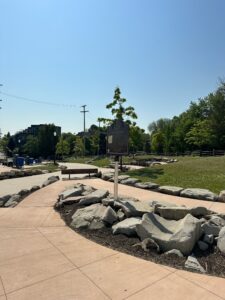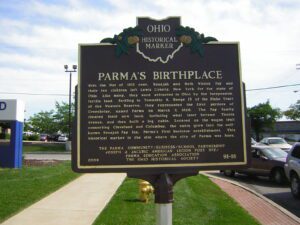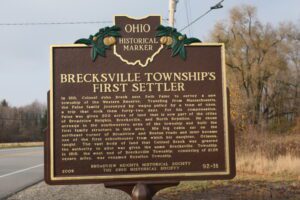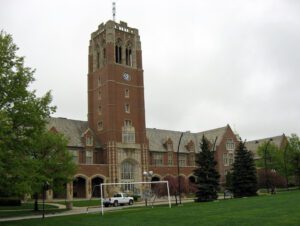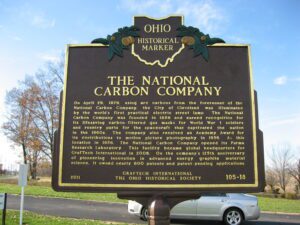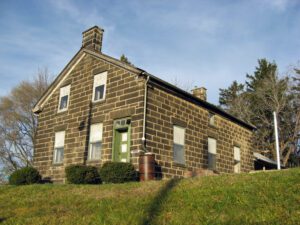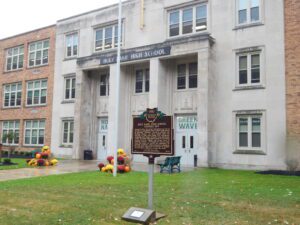, OH
Opened in July 1862, the 35 1/2-acre site here in Brooklyn Township’s University Heights served as the largest Civil War army camp of rendezvous, organization, and training in northeast Ohio. It was bordered by Hershel (now West 5th) and University (now West 7th) streets and Railway and Marquard avenues. A wartime high of 4,151 volunteers occupied the barracks here on December 5, 1862. Lieutenant William Dustin of the 19th Ohio Volunteer Artillery wrote, “It was a table land above the city and admirably suited to the use of a camp of instruction. It was as level as a floor and carpeted with grass. The capacious pine barracks held about 25 each of the battery’s men.” A total of 15,230 men trained here during the war–4.9 percent of the 310,646 enlistments in Ohio. More than 11,000 soldiers were discharged here at war’s end. It closed in August 1865. (continued on other side)
, OH
With the War of 1812 over, Benajah and Ruth Wilcox Fay and their ten children left Lewis County, New York for the state of Ohio. Like many, they were attracted to Ohio by the inexpensive, fertile land. Settling in Township 6, Range 13 of the Blake Tract of the Western Reserve, they represented the first settlers of Greenbriar, named Parma on March 7, 1826. The Fay family cleared their new land, including what later became Theota Avenue, and then built a log cabin. Located on the wagon trail connecting Cleveland and Columbus, the cabin grew into the well-known Benajah Fay Inn, Parma’s first business establishment. This historical marker is the site where the city of Parma was born.
, OH
In 1811, Colonel John Breck sent Seth Paine to survey a new township of the Western Reserve. Traveling from Massachusetts, the Paine family journeyed by wagon pulled by a team of oxen, a trip that took them forty-two days. For his compensation, Paine was given 200 acres of land that is now part of the cities of Broadview Heights, Brecksville, and North Royalton. He chose acreage in the southwestern area of the township and built the first family structure in this area. His log cabin sat on the northeast corner of Broadview and Boston roads and later became one of the first schoolhouses from which his daughter, Orianna, taught. The vast body of land that Colonel Breck was granted the authority to allot was given the name Brecksville Township. In 1818, the west end of Brecksville Township, consisting of 21.28 square miles, was renamed Royalton Township.
, OH
A bond issue passed by the voters of Parma and Parma Heights Township in 1919 funded the construction of Parma’s first high school. It was located at this site on Ridge Road, south of Ridgewood Drive (then Bean Road) and was dedicated in October 1921. Charles W. Bates designed the school as a single story building, but two years later a second story was added. The first graduating class in 1922 consisted of six students, two boys and four girls. In 1928, the land behind the school became the football field. The Parma High School building became a junior high in 1937 and then in the 1950s, Ridge Road Elementary. From 1962 to 2006 the old high school was the Parma City Schools’ Board of Education. The building was demolished in October 2010.
, OH
John Carroll University opened its doors as Saint Ignatius College on September 6, 1886. Originally located on Cleveland’s West Side, the College was founded at the request of Bishop Richard Gilmour by German members of the Society of Jesus (the Jesuits, founded in 1540). In 1923, the College was renamed John Carroll University after America’s first bishop. In 1925, the University acquired land in Idlewood Village (now University Heights) and initiated construction of a new campus in 1931. Classes began there in 1935 with 456 students. The institution admitted laywomen to evening and graduate classes in the 1930s and officially became coeducational in 1968. The University’s Jesuit Catholic mission inspires individuals to excel in learning, leadership, and service, both regionally and worldwide. John Carroll University is one of 28 Jesuit institutions of higher learning in the United States.
, OH
On April 29, 1879, using arc carbons from the forerunner of the National Carbon Company, the City of Cleveland was illuminated by the world’s first practical electric street lamp. The National Carbon Company was founded in 1886 and earned recognition for its lifesaving carbon-filtered gas masks for World War I soldiers and reentry parts for the spacecraft that captivated the nation in the 1960s. The company also received an Academy Award for its contributions to motion picture photography in 1956. At this location in 1956, The National Carbon Company opened its Parma Research Laboratory. This facility became global headquarters for GrafTech International in 2006. On the company’s 125th anniversary of pioneering innovation in advanced energy graphite material science, it owned nearly 800 patents and patent-pending applications.
, OH
The Henninger Homestead was founded in an era when local quarries provided raw materials for the construction of the Ohio and Erie Canal. Bavarian immigrants Philip and Sophia Henninger came to Parma Township in 1840. Although Philip was a skilled tinsmith, he soon established a quarry on his property to supply sandstone for the breakwall of Cleveland’s harbor in Lake Erie, canal locks, and other building projects. In 1849, the Henningers replaced their log home with this Greek Revival house using stone from their quarry. Blocks at its base measure 30″ thick while upper walls are 14″ thick. Abandoned in 1988, the site was saved from demolition in 2003. The house and nearby carriage barn stand as the oldest buildings in the City of Parma.
, OH
Founded in 1914, Holy Name High School was one of the first co-educational Roman Catholic high schools in Cleveland. Originally located at Harvard and Broadway Avenues, the school opened under the direction of Holy Name Parish with educational leadership of the Sisters of Charity from Cincinnati. In 1978, Holy Name High School moved to its present location in Parma Heights, the former home of Nazareth Academy. Throughout its history, Holy Name High School has served the community by providing a Catholic, college-preparatory education. The Holy Name spirit lives on through its alumni, who have made a difference around the world.


